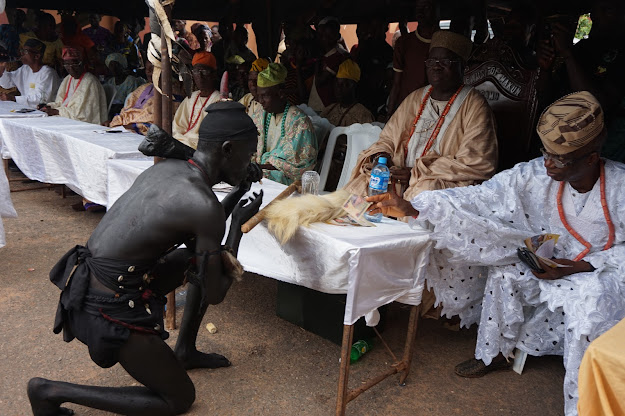Èṣù, is an òrìṣà (spirits sent by Olodumare (God) ) in the Yoruba religion of the Yoruba people or the guidance of all creation and of humanity in particular, on how to live and be successful on Ayé (Earth). (originating from Yorubaland an area in and around present-day Nigeria).
Esu is an orisa (a god or spirit), so instead of four hundred supernatural powers, the Yoruba often speak of four hundred and one, Esu being the divinity on top of the four hundred. He is regarded as one of the most powerful orisa, capable of changing his form at will. Each odu (an odu is a chapter of Ifa, an immense volume of traditions, consisting of 256 chapters, or odu; each odu contains from six hundred to eight hundred poems known as Ese Ifa, totalling as many as 204, 800 poems) is governed by its own Esu. There are 256 different forms of existence that Esu can assume.
Esu is known as the "Father who gave birth to Ogboni", and is also thought to be agile and always willing to rise to a challenge. Both ocha and Ifá share some paths, however. Esu Ayé is said to work closely with Orisa Olokun and is thought to walk on the shore of the beach. Eshu Bi is a stern and forceful avatar, appearing as both an old man and young boy, who walked with Sangó and Oyá (the initial two Ibeyi), and Esu Bi protects both of these, as well as all other small children. Esu Laroye is an avatar believed to be the companion of Osún and believed to be one of the most important Esus, and the avatar of Esu Laroye is thought to be talkative and small.
But Esu is also a kinsman of the Ajogun, malevolent supernatural powers; the eight Ajogun warlords are his errand boys. Esu is like an impartial judge who mediates between the benevolent and malevolent supernatural powers. He is able to do this by using a sacrifice provided by a would-be victim. When Esu presents the sacrifice to a warring Ajogun, the Ajogun allows his victim to go away unhurt. But if a would-be victim does not perform sacrifice, Esu is not in a position to help him.
Other Names
The name of Esu vary around the world: in Yorùbáland, Esu is Èṣù-Elegba or Laolu-Ogiri Oko; Exu de Candomblé in Candomblé; Echú in Santería and Latin America; Legba in Haitian Vodou; Leba in Winti; Exu de Quimbanda in Quimbanda; Lubaniba in Palo Mayombe; and Exu in Latin America.[1]
Umbanda
The shrine dedicated to Esu is located outside of the main terreiro of a Candomblé temple, usually near the entrance gate. It is, in general, made of rough clay or a simple mound of red clay. They are similar to those found in Nigeria.Ritual foods offered to Exu include palm oil; beans; corn, either in the form of cornmeal or popcorn; farofa, a manioc flour. Four-legged male birds and other animals are offered as sacrifice to Exu. In each offering made to an orixá, a part of the food is separated and dedicated to Exu.
ESU AT EWUSI PALACE
There was a display by 'ESU Perfomers' back in 2018 at Ewusi Palace, Sagamu, venue of my father's 75th birthday ceremony, the Ewusi of Makun Kingdom . It was indeed a great spectacle to witness the mesmerising and enchanting displays of the 'performers'. They thrilled us with incredible and breathtaking acrobatic displays as well as traditional incantations and the grand finale was when they consumed their Ebo (sacrifice of food offering) in which the head a cock was ripped from it's neck with bare teeth a sight which is truly not for the fainthearted.
Esu Trilling us with their acrobatic displays
 |
| Paying homage to my father, Ewusi of Makun at the Palace |
 |
| Displaying their acrobatic powress |



Esu consuming their Ebo (Sacrifice)
Controversy on English translations and on GoogleThere seems to have been controversy from the first English Translations of Yorùbá words in the mid nineteenth century, Èṣù has been defined to be the "devil" or "satan". The first evidence of this came Samuel Ajayi Crowther's "Vocabulary of the Yoruba" (1842) where his entries for "Satan" and "Devil" had Esu in English. Subsequently, dictionaries over the years seem to have followed the same route to the disapproval of popular culture and Yoruba societies as well.
There have been several online campaigns recently to protest this, and many activisys have worked to correct it.There have also been quite a number of academic work explaining the mistranslation.The translation on Google Translate took up the same earlier mistranslations. This led to a number of online campaigns until 2016 when Nigerian linguist and writer Kola Tubosun, then an employeeat Google, first changed it back to less derogatory connotations. And when the changes werereverted, he changed them again in 2019. The translation for Èṣù to English now remains "Èṣù"while 'devil' and 'satan' translate to 'bìlísì' and 'sàtánì' respectively.

No comments:
Post a Comment